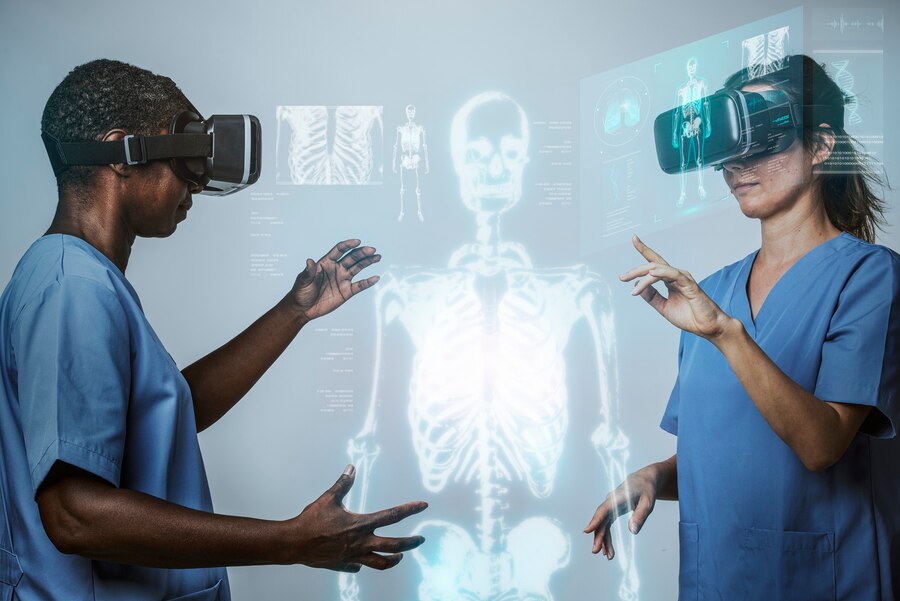In today’s dynamic healthcare landscape, technological advancements are reshaping the industry at an unprecedented pace. From groundbreaking innovations in telemedicine to the integration of artificial intelligence in diagnostics, medical technology is experiencing a revolution. This blog explores the transformative trends driving this evolution and their profound impact on the delivery of healthcare services.
With an emphasis on accessibility, efficiency, and accuracy, these emerging technologies are improving patient outcomes and streamlining healthcare workflows. The possibilities seem limitless, from wearable devices monitoring vital signs in real time to virtual reality aiding in surgical simulations. Join us as we delve into the exciting world of medical tech trends and uncover how they revolutionize our approach to healthcare.
Telemedicine Expansion: Bridging Distances
Telemedicine’s rapid expansion transcends geographical barriers, connecting patients with healthcare professionals regardless of location. Through video consultations and remote monitoring, individuals gain access to medical expertise and resources without physical travel, enhancing convenience and increasing healthcare accessibility for diverse populations.
AI Diagnostics: Precision In Analysis
Artificial intelligence algorithms revolutionize diagnostic processes by swiftly analyzing vast datasets with unparalleled accuracy. From identifying anomalies in medical images to predicting disease progression based on patient data, AI-driven diagnostics empower healthcare providers to make informed decisions swiftly, leading to earlier detection and more effective treatments for various conditions.
Wearable Vital Monitors: Tracking Health
Wearable sensors continuously monitor vital signs such as heart rate, blood pressure, and activity levels, giving individuals real-time insights into their health status. By facilitating proactive health management and early detection of abnormalities, these monitors empower users to take proactive steps towards maintaining optimal well-being and preventing potential health complications.
- Continuous Monitoring: Wearable vital monitors provide real-time tracking of essential health metrics such as heart rate, blood pressure, and sleep patterns, enabling individuals to monitor their health continuously throughout the day and night for a comprehensive understanding of their well-being.
- Proactive Health Management: By offering insights into physiological changes and trends over time, wearable monitors empower users to take proactive steps towards improving their health and lifestyle choices. This includes adjusting exercise routines, sleep habits, and stress management techniques based on personalized data feedback.
- Early Detection of Abnormalities: With the ability to detect subtle deviations from average baseline values, wearable monitors facilitate early identification of potential health problems such as erratic heartbeats or variations in blood pressure. This early detection enables timely intervention and medical consultation, potentially preventing more serious health complications.
- Remote Monitoring: Wearable devices with wireless connectivity allow medical professionals to monitor patients’ vital signs and health status remotely outside traditional clinical settings. This capability is precious for individuals with chronic conditions or those recovering from surgery, as it enables proactive management and timely intervention in emergencies.
- Improved Patient Engagement: By giving individuals access to their health data in an easily understandable format, wearable vital monitors promote greater engagement and accountability in managing one’s health. This increased awareness fosters a sense of ownership over one’s well-being and encourages adherence to recommended lifestyle changes and treatment plans.
Virtual Reality Surgery: Simulated Precision
Virtual reality simulations offer surgeons immersive training experiences and pre-operative planning tools, enabling them to practice complex procedures in a risk-free environment. By refining surgical techniques and enhancing spatial awareness, VR technology enhances surgical precision and reduces the likelihood of complications, ultimately improving patient outcomes and safety.

Remote Patient Monitoring: Continuous Care
Remote patient monitoring systems enable healthcare providers to track patients’ health metrics and vital signs remotely outside traditional clinical settings. This continuous monitoring facilitates early detection of health issues, proactive interventions, and personalized care plans, enhancing patient engagement, satisfaction, and overall health outcomes.
3D Printing in Medicine: Custom Solutions
3D printing technology revolutionizes medical manufacturing by enabling the production of customized implants, prosthetics, and anatomical models tailored to individual patient needs. This innovation enhances treatment precision, accelerates recovery, and improves patient satisfaction by offering personalized solutions that match patients’ unique anatomical characteristics and medical requirements.
- Customized Implants: 3D printing technology enables the fabrication of patient-specific implants tailored to individual anatomical requirements. This customization ensures a precise fit, reduces the risk of complications, and enhances the overall success rates of procedures such as joint replacements, dental implants, and cranial reconstructions.
- Patient-Specific Prosthetics: With 3D printing, prosthetic limbs and other assistive devices can be customized to match individual patients’ unique anatomical characteristics and functional needs. This personalization improves comfort, functionality, and aesthetics, empowering users to regain mobility and independence with greater confidence and satisfaction.
- Anatomical Models for Surgical Planning: Surgeons can utilize 3D-printed anatomical models derived from patient imaging data to simulate complex surgical procedures and plan optimal approaches. These lifelike models provide tactile feedback and spatial visualization, enhancing surgical precision, reducing operating time, and minimizing risks associated with unforeseen anatomical variations.
- Biofabrication of Tissue Constructs: 3D bioprinting technology enables the fabrication of tissue constructs and organ scaffolds using patient-specific cells and biomaterials. This groundbreaking approach holds promise for regenerative medicine applications, including tissue engineering, organ transplantation, and drug discovery, by offering personalized solutions for repairing and replacing damaged or diseased tissues.
Blockchain In Healthcare: Secure Data
Blockchain technology ensures the integrity, security, and privacy of healthcare data by creating a decentralized and immutable ledger of transactions. By enhancing data interoperability, transparency, and trust among stakeholders, blockchain solutions streamline data management processes, facilitate secure information exchange, and safeguard sensitive patient information against unauthorized access and tampering.
Immutable Data Records
Blockchain technology creates a tamper-proof ledger of healthcare transactions, ensuring the integrity and immutability of patient data. This transparency and traceability reduce the risk of data manipulation, fraud, and unauthorized access, enhancing overall data security and trust among stakeholders.
Decentralized Data Management
Blockchain decentralized healthcare data storage and management, eliminating single points of failure and reducing the vulnerability to cyberattacks. By distributing data across a network of nodes, blockchain enhances data resilience and availability while reducing the possibility of system outages and data breaches.
Patient-Controlled Data Sharing
Blockchain-based solutions empower patients to maintain ownership and control over their health data, granting them the authority to share access with healthcare providers and other authorized entities selectively. This patient-centric approach enhances privacy, consent management, and interoperability while fostering greater patient engagement and trust in the healthcare ecosystem.
Robotics in Surgery: Precision Assistance
Surgical robots assist healthcare providers in performing minimally invasive procedures with unparalleled precision and skill. By enhancing surgeons’ capabilities and reducing human error, robotic systems improve surgical outcomes, shorten recovery times, and minimize patient discomfort, enhancing patient satisfaction and reducing healthcare costs in the long run.
Genomic Medicine: Personalized Treatments

Genomic medicine leverages DNA sequencing and analysis advancements to tailor medical treatments and interventions to individuals’ genetic profiles. By identifying genetic predispositions to diseases and optimizing treatment efficacy, genomic medicine offers personalized healthcare solutions that enhance the quality of life and patient outcomes by optimizing treatment benefits and reducing side effects.
- Genetic Profiling: Genomic medicine involves analyzing an individual’s genetic makeup to identify specific variations associated with disease susceptibility, drug responses, and treatment outcomes. This personalized approach enables healthcare providers to tailor treatments based on each patient’s unique genetic profile, optimizing therapeutic efficacy and minimizing adverse reactions.
- Targeted Therapies: By understanding the genetic underpinnings of diseases, genomic medicine enables the development of targeted therapies that address the underlying molecular mechanisms driving a patient’s condition. These precision treatments are designed to selectively inhibit disease pathways while sparing healthy tissues, resulting in more effective and less toxic interventions.
- Pharmacogenomics: Genomic medicine integrates pharmacogenomic data to forecast a person’s reaction to a particular drug depending on their genetic makeup. This personalized approach helps healthcare providers optimize drug selection, dosing, and treatment strategies, maximizing therapeutic benefits and reducing the possibility of negative medication responses and treatment failures.
Augmented Reality In Training: Enhanced Learning
Augmented reality technologies enrich medical education and training by overlaying digital information in real-world environments. By providing immersive learning experiences, AR enhances trainees’ understanding of complex anatomical structures, surgical procedures, and medical concepts, fostering skill development, knowledge retention, and confidence among healthcare professionals.
- Immersive Simulations: Augmented reality (AR) technology immerses trainees in interactive simulations that replicate real-world medical scenarios, enabling hands-on learning experiences without the need for physical patient encounters or invasive procedures.
- Enhanced Visualization: AR overlays digital information, such as anatomical structures or procedural steps, onto the trainee’s field of view in real time, enhancing visualization and understanding of complex medical concepts and techniques.
- Interactive Feedback: AR training applications provide immediate feedback and guidance to trainees as they perform simulated tasks, allowing for iterative practice and skill refinement in a safe and controlled environment. This interactive feedback loop accelerates learning and promotes competency development among healthcare professionals.
Conclusion
The healthcare landscape is undergoing a profound transformation propelled by innovative medical technologies. From telemedicine expanding access to care to AI-driven diagnostics improving accuracy, these advancements are revolutionizing how healthcare is delivered and experienced. Wearable monitors, virtual reality surgeries, and remote patient monitoring ensure continuous care while enhancing patient engagement. Meanwhile, 3D printing, blockchain, and robotics offer personalized solutions, secure data management, and precision assistance in treatments and surgeries. Embracing genomic medicine and augmented reality in training further elevates healthcare standards by providing tailored treatments and enhanced learning experiences.
As these trends evolve, they promise a future where healthcare is more accessible, efficient, and patient-centered than ever before. By harnessing the power of technology, the medical field is poised to overcome challenges, improve outcomes, and, ultimately, revolutionize how we perceive and approach healthcare. Healthcare professionals and stakeholders must embrace these advancements, ensuring they’re harnessed ethically and inclusively to benefit all individuals, regardless of their circumstances or geographical location.



